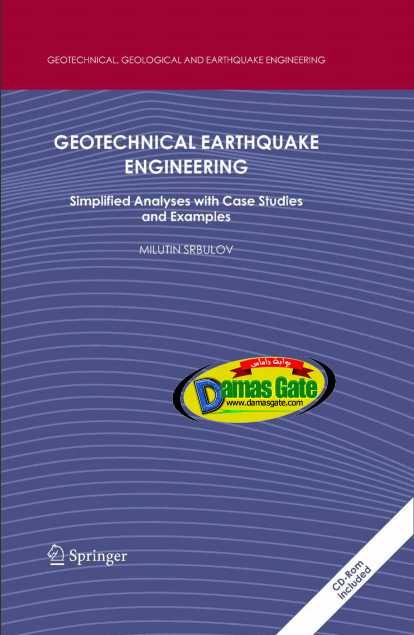Springer Geotechnical Earthquake Engineering

GEOTECHNICAL, GEOLOGICAL AND EARTHQUAKE
ENGINEERING
Vol u me 9
Series Editor
Atilla Ansal, Kandilli Observatory and Earthquake Research Institute,Bo
gazic¸i University, Istanbul, Turkey
Editorial Advisory Board
Julian Bommer, Imperial College London, U.K.
Jonathan D. Bray, University of California, Berkeley, U.S.A.
Kyriazis Pitilakis, Aristotle University of Thessaloniki, Greece
Susumu Yasuda, Tokyo Denki University, Japan
Geotechnical Earthquake
Engineering
Simplified Analyses with Case Studies
and Examples
by
MILUTIN SRBULOV
United Kingdom
with Foreword of
E.T.R. Dean
Preface
This monograph contains descriptions of numerous methods aimed at ease and
speed of use for major problems in geotechnical earthquake engineering. Comments
on assumptions, limitations, and factors affecting the results are given. Case studies
and examples are included to illustrate the accuracy and usefulness of simplified
methods. A list of references is provided for further considerations, if desired. Microsoft
Excel workbooks referred to in Appendices and provided on an accompanying
CD are for the case studies and examples considered in the monograph. Some
of the reasons for using this monograph are mentioned below.
Many codes and standards contain recommendations on best practice but compliance
with them does not necessarily confer immunity from relevant statutory and legal
requirements (as stated in British Standards). Some seismic codes and standards
were revised after major events such as the 1995 Hyogo-ken Nambu and the 1994
Northridge earthquakes. Codes contain clauses without references to the original
sources for more detailed considerations when cases that require such consideration
appear in practice. Codes do not contain explanations of the statements expressed
in them. Codes are brief regarding ground properties and ground response. For
example, Eurocode 8 – Part 5 requires assessment of the effects of soil-structure
interaction in certain circumstances but does not specify the details of the analyses.
Therefore, the use of codes and standards alone may not be sufficient in engineering
practice.
In engineering practice, there is often rather little interaction between structural
and foundation disciplines. Structural engineers often consider ground in a simplified
way using equivalent springs. Geotechnical engineers consider often only
loading from structures on foundations. Dynamic soil-structure interaction is very
complex and analyzed mainly by specialist in geotechnical earthquake engineering.
This monograph should help geotechnical and structural engineers to communicate
effectively to better understand solutions of many problems in geotechnical earthquake
engineering.
Download
http://s18.alxa.net/s18/srvs2/01/Spr...ngineering.rar